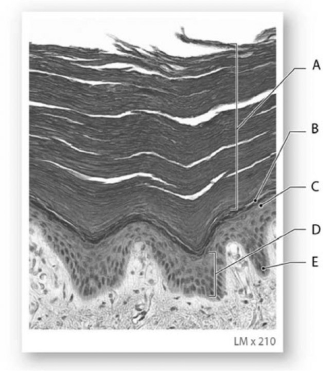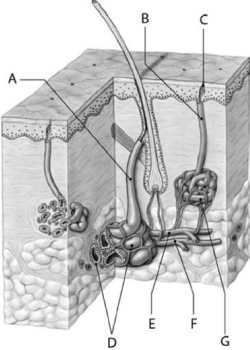A) cervical
B) mesenteric
C) brachial
D) celiac
E) cutaneous
Correct Answer

verified
Correct Answer
verified
Multiple Choice
 Figure 5-1 The General Structure of the Integumentary System
Use Figure 5-1 for the following questions:
-The structure composed of stratified squamous epithelium is
Figure 5-1 The General Structure of the Integumentary System
Use Figure 5-1 for the following questions:
-The structure composed of stratified squamous epithelium is
A) A.
B) B.
C) C.
D) M.
E) L.
Correct Answer

verified
Correct Answer
verified
Multiple Choice
A burn that destroys only the superficial cells of the epidermis, such as a mild sunburn, is classified as
A) first-degree.
B) second-degree.
C) third-degree.
D) fourth-degree.
E) full-thickness.
Correct Answer

verified
Correct Answer
verified
Multiple Choice
Nerve fibers in the dermis most likely function in
A) defending of local tissues after infection.
B) providing nutrients and oxygen to the skin.
C) monitoring sensory receptors in the dermis.
D) repairing tissue after injury.
E) removing carbon dioxide and waste products.
Correct Answer

verified
Correct Answer
verified
Multiple Choice
The highly vascular layer of the skin, which provides thermoregulation via changing blood flow, is the
A) epidermis.
B) subcutaneous layer.
C) stratum basale.
D) stratum corneum.
E) dermis.
Correct Answer

verified
Correct Answer
verified
Multiple Choice
As cells are pushed from the deeper portion of the epidermis toward the surface,
A) they divide.
B) they die.
C) their nutrient supply increases.
D) they enter the dermis.
E) they produce daughter cells.
Correct Answer

verified
Correct Answer
verified
Multiple Choice
During the regeneration process of the skin after an injury, what is the combination of blood clot, fibroblasts, and an extensive capillary network called?
A) keloid
B) granulation tissue
C) scar tissue
D) scab
E) sebum
Correct Answer

verified
Correct Answer
verified
Multiple Choice
The lipid in oil glands is released through which type of secretion?
A) eccrine
B) apocrine
C) merocrine
D) endocrine
E) holocrine
Correct Answer

verified
Correct Answer
verified
Multiple Choice
 Figure 5-1 The General Structure of the Integumentary System
Use Figure 5-1 for the following questions:
-Structure B on the skin diagram is the
Figure 5-1 The General Structure of the Integumentary System
Use Figure 5-1 for the following questions:
-Structure B on the skin diagram is the
A) epidermis.
B) dermis.
C) subcutaneous layer.
D) cutaneous membrane.
E) hypodermis.
Correct Answer

verified
Correct Answer
verified
Multiple Choice
 Photo Credit: Robert B. Tallitsch
Figure 5-2 The Strata of the Epidermis in Thick Skin
Use Figure 5-2 to answer the following questions:
-The part of the skin at the bottom of the picture, seen in a lighter shade of gray, is the
Photo Credit: Robert B. Tallitsch
Figure 5-2 The Strata of the Epidermis in Thick Skin
Use Figure 5-2 to answer the following questions:
-The part of the skin at the bottom of the picture, seen in a lighter shade of gray, is the
A) strata.
B) carotene.
C) dermis.
D) cornified region.
E) hypodermis.
Correct Answer

verified
Correct Answer
verified
Multiple Choice
 Photo Credit: Robert B. Tallitsch
Figure 5-2 The Strata of the Epidermis in Thick Skin
Use Figure 5-2 to answer the following questions:
-The lowest level of cells of the strata, marked E, consists of
Photo Credit: Robert B. Tallitsch
Figure 5-2 The Strata of the Epidermis in Thick Skin
Use Figure 5-2 to answer the following questions:
-The lowest level of cells of the strata, marked E, consists of
A) keratin protein.
B) collagen fibers.
C) dead cells.
D) carotene-producing cells.
E) mitotically active epithelial cells.
Correct Answer

verified
Correct Answer
verified
Multiple Choice
 Figure 5-4 Glands and Associated Structures
Use Figure 5-4 to answer the following questions:
-Structure D is a(n)
Figure 5-4 Glands and Associated Structures
Use Figure 5-4 to answer the following questions:
-Structure D is a(n)
A) endocrine gland.
B) sebaceous gland.
C) merocrine gland.
D) apocrine gland.
E) unicellular gland.
Correct Answer

verified
Correct Answer
verified
Multiple Choice
Which of the following is the function of the combination of epidermal ridges and dermal papillae?
A) increase storage of nutrients in the digestive tract
B) increase surface area for diffusion between the dermis and epidermis
C) increase sensory reception
D) increase secretion of milk in specialized integumentary glands
E) increase large reserves of lipids in adipose tissue
Correct Answer

verified
Correct Answer
verified
Multiple Choice
Which statement is true for merocrine sweat glands?
A) They discharge their secretions into the hair follicles.
B) They are for hair lubrication.
C) They are more numerous than apocrine sweat glands.
D) They are important in communication between individuals, related to sexual attraction.
E) They make the skin more pliable and soft.
Correct Answer

verified
Correct Answer
verified
Multiple Choice
Projections of loose connective tissue from the dermis, which extend upward between the adjacent ridges of the epidermis, are called
A) epidermal ridges.
B) strata.
C) reticular layers.
D) accessory structures.
E) dermal papillae.
Correct Answer

verified
Correct Answer
verified
Multiple Choice
You fell on the concrete walkway and scraped your leg against the solid surface, which created a two-inch by three-inch area that is not bleeding. This would be called a(n)
A) abrasion.
B) laceration.
C) puncture.
D) incision.
E) contusion.
Correct Answer

verified
Correct Answer
verified
Multiple Choice
Perspiration that is produced by apocrine sweat glands
A) is more than 99 percent water.
B) contains electrolytes and waste products, such as urea.
C) helps to cool the surface of the skin when it evaporates.
D) is limited to the hair follicles of the axilla, nipples, and groin.
E) contains astringent compounds that contract the skin and its sweat gland pores.
Correct Answer

verified
Correct Answer
verified
Multiple Choice
The function of the arrector pili is
A) diffusion.
B) thermoregulation.
C) lubrication.
D) contraction.
E) fat storage.
Correct Answer

verified
Correct Answer
verified
Multiple Choice
The ________ is associated with the puckering of skin and the pulling of the hair follicle.
A) arrector pili
B) hypodermis
C) dermal papilla
D) epidermal ridge
E) stratum basale
Correct Answer

verified
Correct Answer
verified
Multiple Choice
Choose the correct order of the cell layers, or strata, in a section of thick skin, from the basement membrane toward the free surface (deep to superficial) . 1. stratum lucidum 2. stratum basale 3. stratum corneum 4. stratum granulosum 5. stratum spinosum
A) 3, 5, 4, 1, 2
B) 3, 4, 1, 5, 2
C) 2, 1, 4, 5, 3
D) 2, 4, 5, 3, 1
E) 2, 5, 4, 1, 3
Correct Answer

verified
Correct Answer
verified
Showing 61 - 80 of 103
Related Exams